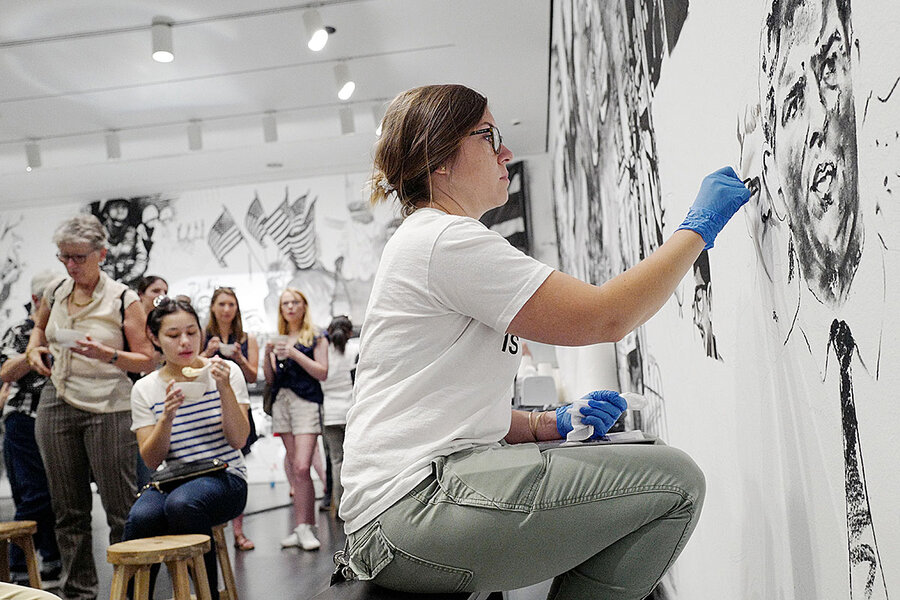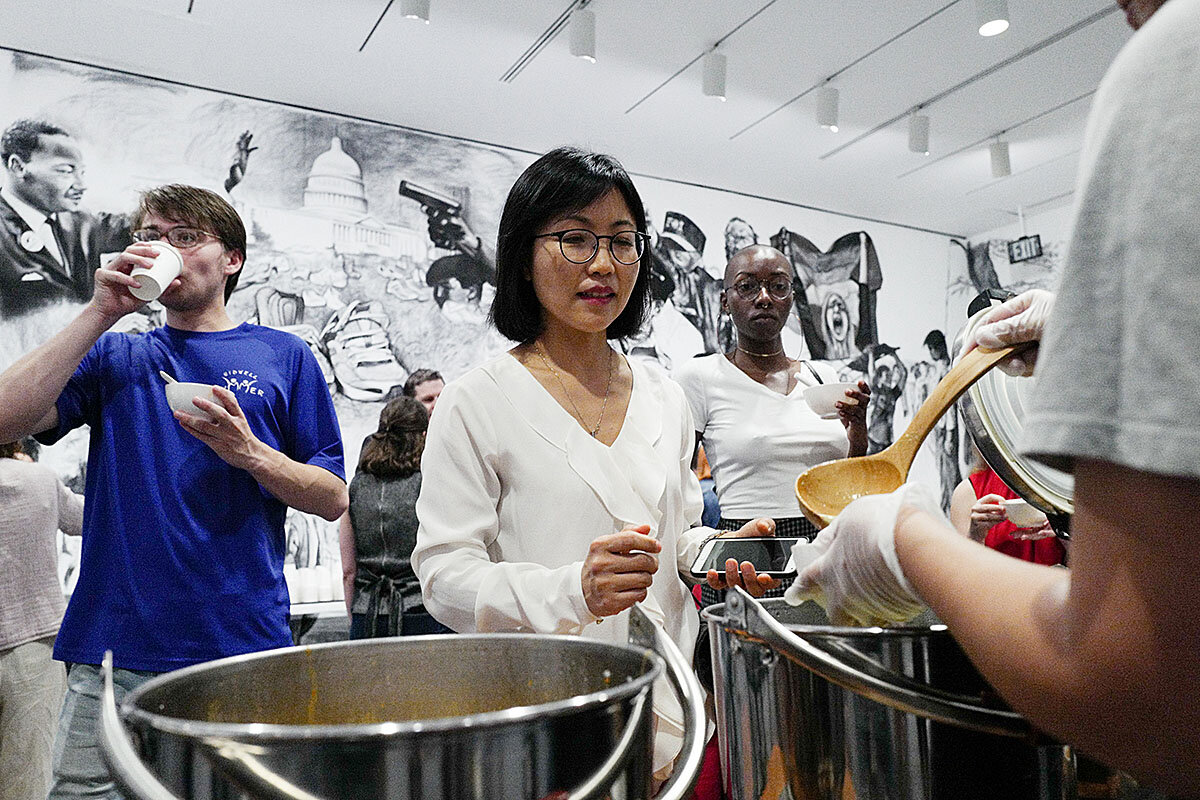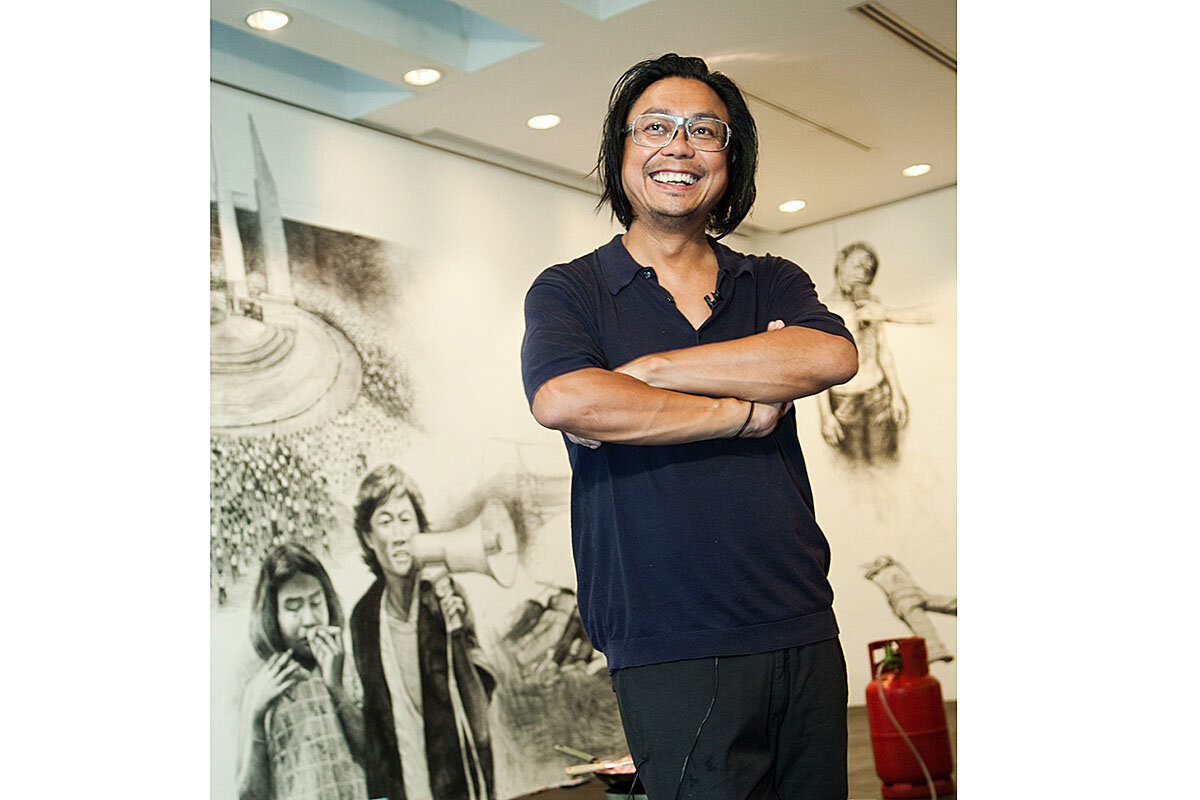Welcome to the museum. Did you bring a spoon?
Loading...
| Washington
On the subterranean floor of the Smithsonian’s Hirshhorn Museum, a new exhibition appears to flummox two visitors. A middle-aged man and woman linger at the doorway, their expressions quizzical as they take stock of the scene.
There aren’t any framed pictures, sculptures, or artistic objects inside the tennis court-sized room, which is bustling with visitors. Instead, the four walls feature charcoal murals depicting political turmoil and protests. Museumgoers shuffle around the space, pausing to take in images such as Parkland shooting survivor-activist Emma González, her short hair rendered in porcupine strokes. But the most unusual activity inside the hall isn’t the presence of an artist sketching a tank on one of the walls. In the center of the room, two people standing at a table serve up bowls of Thai food. An aroma of curry, sweet and spicy, wafts from their steaming pots.
The two tourists at the entryway turn on their heels, perhaps unsure what to make of it all. In doing so, they’ve missed out on a free lunch – and one of Washington’s buzziest new exhibitions. Rirkrit Tiravanija’s “Who’s Afraid of Red, Yellow, and Green,” which runs through July 24, incorporates Thai dishes as part of the installation. In fact, Mr. Tiravanija views the act of communal dining inside the museum as a work of art in and of itself. The concept, dubbed “relational aesthetics,” is as tasty as it is meta. It’s also the latest example of how some museums are pairing food, now something of an art form in its own right, with the art-viewing experience.
Why We Wrote This
Wandering through galleries requires only a few of the senses. By introducing food, artists and institutions are transforming a passive experience. Will it bring about more interaction, as hoped?
“This move on the part of Hirshhorn, which is also reflected in other institutions, is this idea of a different kind of engagement with the general public,” says Mark Beasley, curator of media and performance art at the Hirshhorn. “Relational aesthetics is completed by engagement with an audience. So it needs people in that room eating that curry. It needs artists doing live drawing. It needs this kind of sociability of the work or the installation for the work to complete itself.”
Introducing food into art exhibitions transforms museum-going from the sometimes yawn-stifling experience of wandering quietly from room to room. Plus, engaging visitors’ taste buds helps them forge a more personal connection to the artwork.
The Carnegie Museum of Art in Pittsburgh accomplishes those goals by hosting occasional events that synchronize meals with the themes of art exhibitions. For example, Brazilian chef Ana Luiza Trajano flew to Pittsburgh to prepare a dinner to accompany a 2016 art exhibition by fellow Brazilian Hélio Oiticica. (“She brought two suitcases full of food, somehow, through the airport,” laughs Laura McDermit, the museum’s manager of social experiences.) Both the chef and the artist are renowned for “cultural cannibalism” – appropriating global influences into their Brazilian traditions.
“Food is such a great connector,” says Ms. McDermit. “That’s another way for us to get people to interact with, and maybe connect with, the art in that very sort of simple way, which is over a meal and with making new friends.”
Similarly, the Metropolitan Museum of Art in New York invited Israeli chef Yotam Ottolenghi to prepare a medieval-themed meal for its 2016 exhibition “Jerusalem 1000-1400: Every People Under Heaven.” At 13 courses, the feast gave visitors plenty of time to digest the ancient artworks on display.
Museum exhibitions often have to display cuisine art in a separate area from regular exhibitions as a matter of practicality. When the Cooper Hewitt, Smithsonian Design Museum in New York explored the sensation of taste as part of its 2018 exhibition “The Senses: Beyond Vision,” they weren’t able to bring actual food into the gallery. It carried a risk of introducing pests that could harm the museum collection. Instead, the museum found ingenious ways to represent taste, including an exhibit of an Ode scent player.
“You can add in these different scent discs which emit the smell of food,” explains Andrea Lipps, associate curator of contemporary design at Cooper Hewitt. “So that was also how we kind of brought in this idea of even just smelling itself and the power that that had just even on appetite stimulation.”
Mr. Tiravanija, who was also included in the University of Chicago’s Smart Museum of Art’s “Feast” in 2012, has long been renowned for cooking meals inside galleries. His current work at the Hirshhorn reflects his Thai heritage in more ways than one. He was taught to cook by his grandmother, a noted chef. The red, yellow, and green curries in his exhibition (only available in the exhibit Thursday through Sunday) mirror the colors of three political factions in Thailand. The associated murals, which look like black-and-white stills from a CNN broadcast, include disturbing illustrations of Thai protesters killed during anti-government protests between 2009 and 2010. The effect is as pungent as the tongue-blistering red curry.
“It’s weird to eat where there’s a place with a bunch of conflict,” says Eric Blair, who is visiting the museum with two fellow students from Pomona College in Claremont, California. “The curry makes your mouth feel pain when you’re looking at something.”
Mr. Blair’s two friends, Anna Sipowicz and Aidan Moore, opted for the milder green and yellow curries. The murals, too, differ in intensity. For every depiction of brutality, there’s a corresponding image of peace. “Who’s Afraid of Red, Yellow, and Green” acknowledges historical protests on the nearby Washington Mall with murals depicting the Women’s March of 2017, Martin Luther King Jr. delivering his “I Have a Dream” speech, and even a suffragist riding a white horse in 1913.
“I didn’t realize before coming in that there would be different images from different contexts. It seemed like it would be a Thai context,” marvels Mr. Moore, gazing out into the busy room where people have put away their phones so that they can hold their bowls of food. The collective conversations in the room sound more like a dinner party than the morgue-like quiet of most art museums.
“There’s a different kind of communal vibe going on right now,” he says. “It encourages people to talk with the people who are here.”







